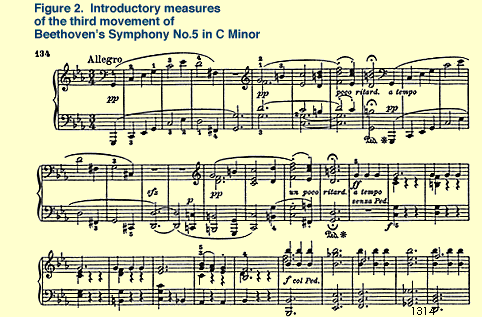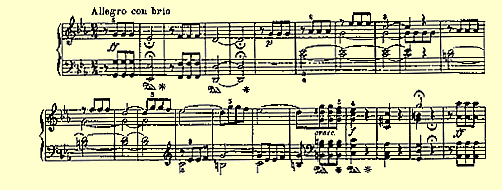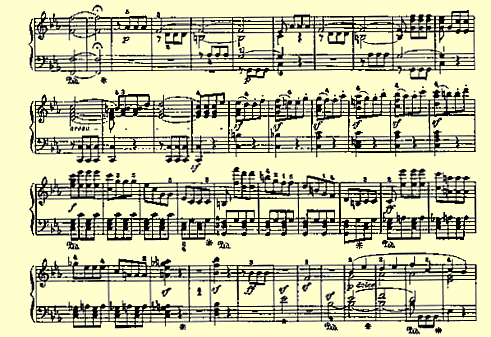What is the subject of Beethoven's Fifth Symphony? Is it just those first four notes? Does it include the twin, transposed companion too? What of the other variations, augmentations, and inversions? Do they all stem from a single prototype? In this case, yes.
Or do they? For later in the symphony the theme appears in triplet form to serve as counter subject of the scherzo: three notes and one, three notes and one, three notes and one, still they make four. Melody turns into monotone rhythm; meter is converted to two equal beats. Downbeat now falls on an actual note, instead of a silence. With all of those changes, the themes are quite different and yet the same. Neither the form in the allegro nor the scherzo alone is the prototype; separate and equal, they span musical time.

Is there some more abstract idea that they both embody? This is like the problem raised by Wittgenstein of what words like game mean. In my paper on frames [Minsky 1974] I argue that for vision, 'chair 'can be described by no single prototype; it is better to use several prototypes connected in relational networks of similarities and differences. I doubt that even these would suffice to well represent musical ideas ; there are better tools in conceptual dependency, frame-systems, and semantic networks. (See Roads, 1980.)
What is a good theme? Without that bad word good, I do not think the question is well formed because anything is a theme if everything is music!
So let us split that question into (1) What mental conditions or processes do pleasant tunes evoke? and (2) What do we mean by pleasant? Both questions are hard, but the first is only hard; to answer it will take much thought and experimentation, which is good. The second question is very different. Philosophers and scientists have struggled mightily to understand what pain and pleasure are. I especially like Dennett's [1978] explanation of why that has been so difficult. He argues that pain "works" in different ways at different times, and all those ways have too little in common for the usual definition. I agree, but if pain is not a single thing, why do we talk and think as though it were—and then represent it with such spurious clarity? This is no accident: illusions of this sort have special uses. They play a role connected with a problem facing any society (inside or outside the mind) that learns from its experience. The problem is how to assign the credit and blame, for each accomplishment or failure of the society as a whole, among the myriad agents involved in everything that happens. To the extent that the agents' actions are decided locally, so also must these decisions to credit or blame he made locally.
How, for example, can a mother tell that her child has a need (or that a need has been satisfied) before she has learned specific signs for each such need? That could be arranged if, by evolution, signals were combined from many different internal processes concerned with needs and were provided with a single, common, output–an infant's sentic signal of discomfort (or contentment). Such a genetically pre-established harmony would evoke a corresponding central state in the parent. We would feel this as something like the distress we feel when babies cry.
A signal for satisfaction is also needed. Suppose, among the many things a child does, there is one that mother likes, which she demonstrates by making approving sounds. The child has just been walking there, and holding this just so, and thinking that, and speaking in some certain way. How can the mind of the child find out which behavior is good? The trouble is, each aspect of the child's behavior must result from little plans the child made before. We cannot reward an act. We can only reward the agency that selected that strategy, the agent who wisely activated the first agent, and so on. Alas for those behaviorists who wasted their lives life by missing this simple principle.
To reward all those agents and processes, we must propagate some message that they all can use to credit what they did; the plans they made, their strategies and computations. These various recipients have so little in common that such a message of approval, to work at all, must be extremely simple. Words like good are almost content-free messages that enable tutors, inside or outside a society, to tell the members that one or more of them has satisfied some need, and that tutor need not understand which members did what, or how, or even why.
Words like 'satisfy' and 'need' have many shifting meanings. Why, then, do we seem to understand them? Because they evoke that same illusion of substantiallity that fools us into thinking it tautologous to ask, why do we like pleasure? This serves a need: the levels of social discourse at which we use such clumsy words as 'like', or 'good', or 'that was fun' must coarsely crush together many different meanings or we will never understand others (or ourselves) at all. Hence that precious, essential poverty of word and sign that makes them so hard to define. Thus the word 'good' is no symbol that simply means or designates, as 'table' does. Instead, it only names this protean injunction: Activate all those unknown processes that correlate and sift and sort, in learning, to see what changes (in myself) should now be made. The word like is just like good, except it is a name we use when we send such structure-building signals to ourselves.
Most of the "uses" of music mentioned in this article–learning about time, fitting things together, getting along with others, and suppressing one's troubles–are very "functional, but overlook much larger scales of "use." Curtis Roads remarked that, "Every world above bare survival is self constructed; whole cultures are built around common things people come to appreciate." These appreciations, represented by aesthetic agents, play roles in more and more of our decisions: what we think is beautiful gets linked to what we think is important. Perhaps, Roads suggests, when groups of mind-agents cannot agree, they tend to cede decisions to those others more concerned with what, for better or for worse, we call aesthetic form and fitness. By having small effects at many little points, those cumulative preferences for taste and form can shape a world.
That is another reason why we say we like the music we like. Liking is the way certain mind-parts make the others learn the things they need to understand that music. Hence liking—and its relatives—lies at the very heart of understanding what we hear. 'Affect' and 'aesthetic' do not lie in other academic worlds that music theories safely can ignore. Those other worlds are academic self-deceptions that we use to make each theorist's problem seem like someone else's.
Note: Many readers of a draft of this article complained about its narrow view of music. What about jazz and other "modern" forms. What about songs with real words, monophonic chants and ragas, music made with gongs and blocks, and all those other kinds of sounds? And what about those listeners who claim to be less intellectual, to simply hear and feel and not to build those big constructions in their minds? We can't discuss here all those things, but we can ask how anyone could be so sure much about what their minds do. It is ingenuous to think that you "just react" to anything a culture works a thousand years to develop. In any case, because it's not my purpose here to define boundaries, it's better to focus in on something that we all agree is musical – and that is why I chose this Symphony. For what is music? All things played on all instruments? Fiddlesticks. All structures made of sound? That has a hollow ring. The things I said of words like 'theme' hold true for words like 'music' too: that word is public property, but not all the senses of its meanings to each different listener.










